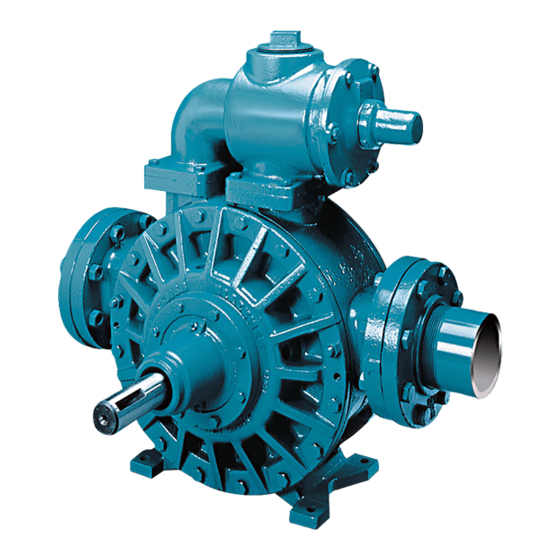Dover PSG BLACKMER MRLX4B 설치, 작동 및 유지보수 지침 - 페이지 8
{카테고리_이름} Dover PSG BLACKMER MRLX4B에 대한 설치, 작동 및 유지보수 지침을 온라인으로 검색하거나 PDF를 다운로드하세요. Dover PSG BLACKMER MRLX4B 20 페이지. Power pumps

MAINTENANCE: M(R)LX(W)4B Series
VANE REPLACEMENT
NOTICE:
Maintenance shall be performed by qualified technicians
only, following the appropriate procedures and warnings
as presented in manual.
1.
Remove the head assembly (20 or 20A) and all other
parts on the outboard (non-driven) side of the pump
according to Steps 1 through 9 of the "Pump
Disassembly" Section.
2.
Turn the shaft by hand until a vane (14) comes to the top
(12 o'clock) position of the rotor.
3.
Remove and replace the vane, making sure to install the
vane with the rounded edge outward to contact the liner
(41).
4.
Rotate the shaft until the next rotor slot is in the top
position, and replace the vane.
5.
Continue this procedure until all new vanes are in place.
6.
Reassemble the pump per "Pump Assembly."
PUMP DISASSEMBLY
NOTICE:
Follow all hazard warnings and instructions provided in
the "Maintenance" section of this manual.
NOTE: The numbers in parentheses following individual parts
indicate reference numbers on the coinciding Parts List.
1.
Remove the bearing cover capscrews (28) and slide the
bearing cover (27) from the shaft, being careful not to cut
the inserted grease seal (104) on the shaft keyway.
2.
Remove the bearing preload wave spring (24C).
3.
Bend up the lockwasher tang (24B) engaged in the
locknut (24A), and turn the locknut counterclockwise to
remove it from the shaft. Slide the lockwasher off the
shaft.
4.
Make sure the shaft is free of any dirt, nicks or burrs
which may cause seal O-ring damage when removing the
hub assembly and rotating seal face.
5.
Remove the hub capscrews (21D). To disengage the hub
assembly from the head, two jackscrew holes are
provided in the rim of the hub. Slide the hub assembly
off the shaft with the bearing, stationary seat, and
stationary O-ring still intact. Once the hub assembly has
been removed from the head, the bearing and stationary
seat can be removed from the hub.
a.
Slide the bearing (24) out of the bearing cavity.
b.
Using a blunt instrument, push or gently tap the
backside (non-polished side) of the stationary seat
(153A) to remove it from the seal recess. Place a
cloth under the seal to avoid damage. Be careful not
to contact the polished surface of the seal face
during removal.
6.
With the use of wire hooks, carefully pull the rotating seal
assembly (jacket, seal face & O-ring) (153B & 153E) out
of the head and off the shaft. Holes in the seal jacket will
facilitate the removal.
7.
Remove the head capscrews (21) and head stud nuts
(21C). Two jackscrew holes are provided in the rim of the
head to facilitate removal.
8.
Remove the head (20 or 20A) from the casing (12), being
careful not to nick or scrape the shaft.
9.
The disc (71) will come off with the head assembly and
is attached with four countersunk, allen-head machine
screws (71A) and lockwashers (71B).
10. In order to remove the rotor and shaft assembly without
damaging the mechanical seal, it is advisable to remove
the second hub assembly and mechanical seal
components from the opposite side of the pump. Follow
Steps 1 through 7.
11. From the open side of the pump, grasp the rotor in the 3
and 9 o'clock positions, and gently pull the rotor and shaft
(13) out of the head assembly remaining on the casing.
CAUTION: Use care to avoid injury, the rotor and shaft is
heavy and may have sharp edges.
12. The remaining head assembly can now be easily
removed. Follow Steps 8 through 10.
13. Depending on the pump application, the liner (41) can be
removed in two ways:
a.
If the pumpage is a clean, non-corrosive liquid, with
low viscosity, the liner can usually be withdrawn from
the casing by prying with two bars. Insert the tips of
the bars into the port openings on either side of the
liner, and partially remove the liner by prying against
the rotor. Use a block under the bar, against the
rotor, to bring the liner the rest of the way out (see
Figure 5).
b.
If the pumpage is corrosive, contains a large
concentration of particulate matter, or is high
viscosity, the liner will most likely have to be driven
out the casing, rather than pried out. To do so, use a
brass or hard wood drift and a hammer and tap
around the diameter of the liner until it is driven out
of the casing.
PARTS REPLACEMENT
1.
If any of the O-rings have been removed or disturbed
during disassembly, they must be replaced with new O-
rings. NOTE: Heat PTFE O-rings in hot water to aid
installation.
2.
Excessive or continuous leakage from the tell-tale hole in
the bearing cover may be an indication of a damaged
mechanical seal. If a mechanical seal has been leaking, it
is recommended the entire seal be replaced. Refer to
"General Pump Troubleshooting" for possible causes of
seal leakage.
106-A00
Page 8/20
Figure 5 – Liner Removal
